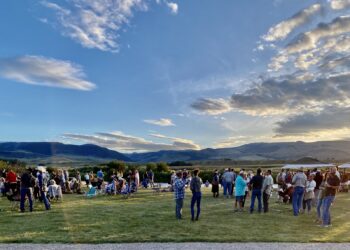By Skip Anderson MSU NEWS SERVICE
A researcher at Montana State University says the underground root system for fungi could play a role in the design of more environmentally friendly building and infrastructure materials.
That root system is composed of a substance called fungal mycelium, and, according to researcher Chelsea Heveran, it could provide a “scaffold” for microorganisms to adhere to and harden through a process called calcification. In some instances, the mycelium scaffold itself can calcify without adding microbes.
Heveran, an assistant professor of mechanical and industrial engineering in MSU’s Norm Asbjornson College of Engineering, is the senior author of a study of mycelium’s material properties published last month in the journal Cell Reports Physical Science. MSU doctoral student Ethan Viles is the publication’s first author.
“Ethan did a tremendous job with this study,” Heveran said. “This work benefitted from his enthusiasm for engineered living materials and his skill in working at the intersection of engineering, materials science and biology.”
Currently, most engineered living materials, or ELMs, are soft, she said. There is an emerging effort, including by MSU researchers, to design load-bearing materials that are also alive. However, keeping biomineralized ELMs alive for more than a few days or weeks has been challenging. In this work, MSU researchers demonstrated that the mycelium scaffold could enable the ELMs to stay alive for at least a month.
“We saw that both the mycelium, or bacteria living on the mycelium scaffold, were abundantly viable a month into investigation, even when we kept it in very hot and dry conditions,” she said. “That is a challenge for microorganisms in these kinds of materials.”
While the initial biomineralization is conducted over the first few days to a week when creating the ELM, it would be advantageous in some settings for the ELM to live longer. This greater viability could open the door to “dynamic features of life,” such as self-healing or regeneration. These features were not reported in the current investigation but are an area of active interest in Heveran’s lab.
“Because [mycelium-based ELMs] stay alive for a longer period of time, maybe they could help heal the material and seal a crack,” she said. “We might also be able to use the living microbes as a sensor in a way that they tell you something about the environment. Basically, once they start staying alive, you might be able to get creative and access a number of things that you would like cells to do.”
Another feature of the mycelium scaffolding allowed the researchers to shape the mycelium in ways that mimicked the internal structure of bone. This is advantageous for engineering structures, Heveran said, because bones are lightweight, yet are strong and tough.
ELMs could also offer environmental benefits compared to concrete, since the production of cement, the binding material in concrete, accounts for as much as 8% of the greenhouse gas carbon dioxide in the atmosphere, according to a 2023 peer-reviewed article that appeared Nature Communications.
“We have a very, very large need for more building and infrastructure materials,” said Heveran, who is affiliated with MSU’s Center for Biofilm Engineering. “And given that concrete specifically has such a large carbon footprint, it is important to generate more sustainable strategies for producing these materials.”
ELMs could offer other advantages as building and infrastructure materials. For example, ELMs have the potential to be made onsite with materials that are, for the most part, locally available.
“Imagine for a moment that we have some kind of disaster in a remote, hard-to-reach area,” Heveran said. “Maybe it’s an earthquake and you need some critical infrastructure like a new road so you can meet the needs of the people there. If we want to make it out of concrete, we need to get the cement there and potentially the aggregate, we need to mix it and pour it, and after that it might takes weeks to even a month before you can use it at full strength.”
In addition to Heveran and Viles, MSU coauthors of the paper include faculty members Robin Gerlach, professor of chemical and biological engineering, and Adrienne Phillips, associate professor of civil engineering. Another MSU doctoral student, one master’s student and two undergraduate students are co-authors of the publication.













